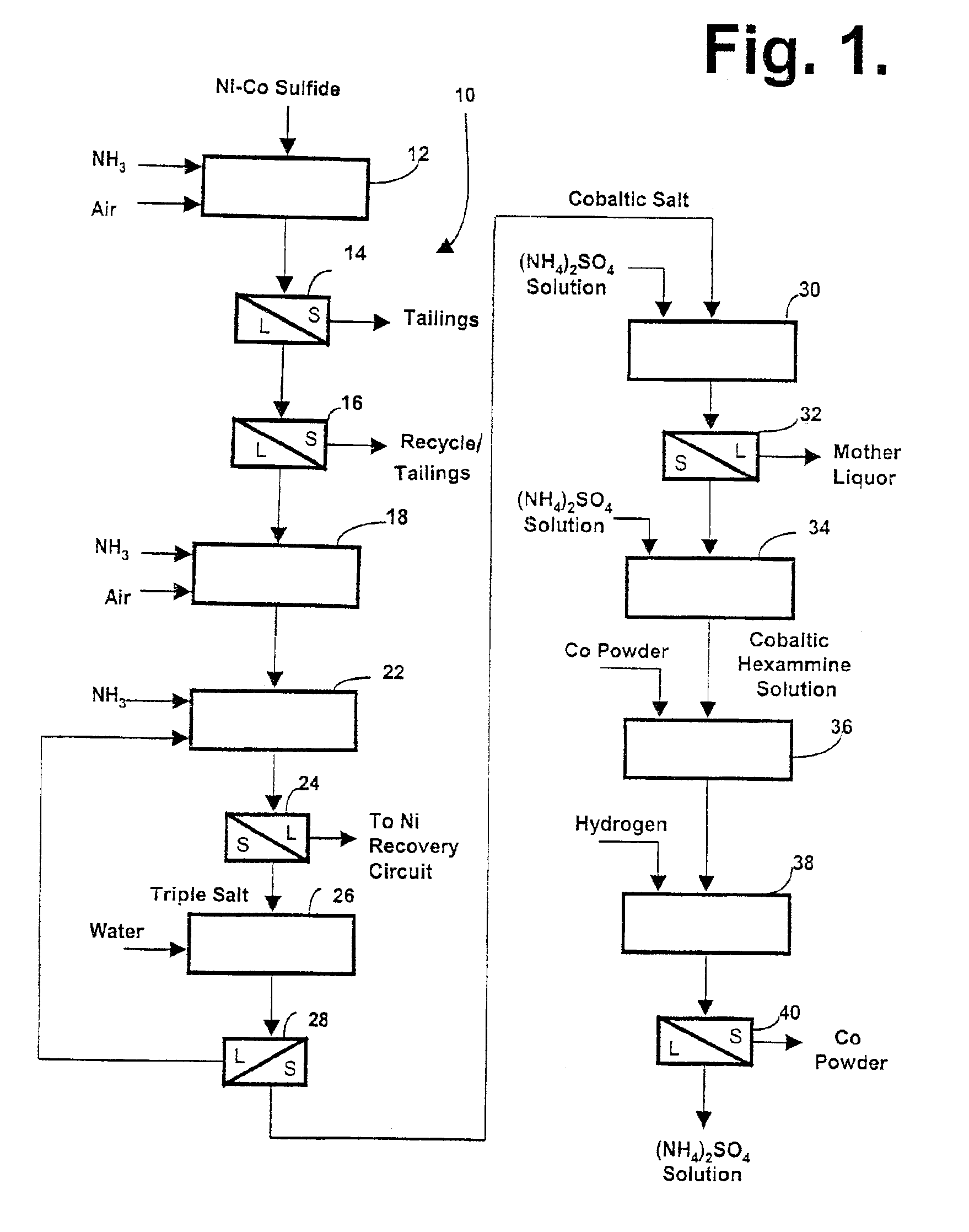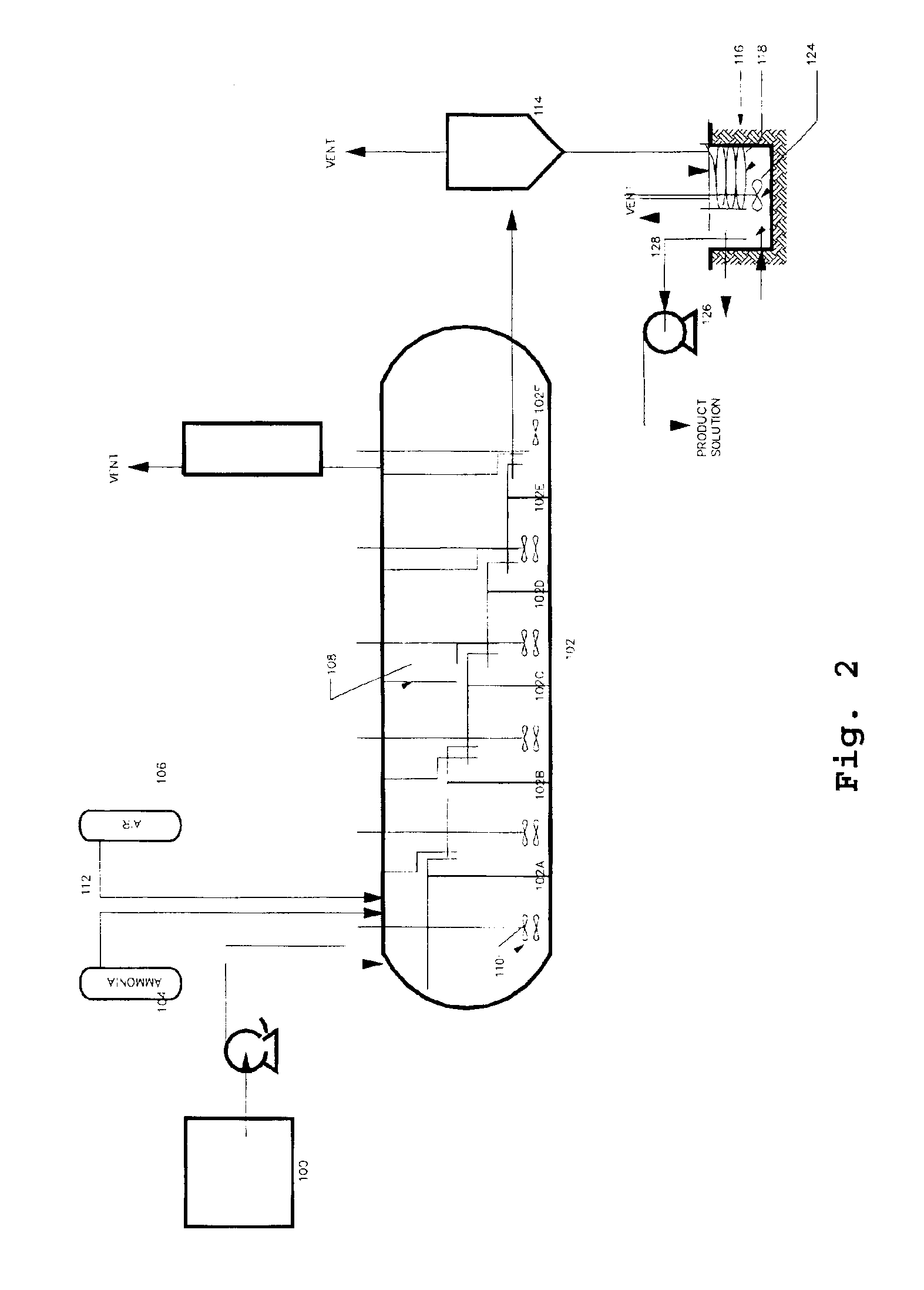Producing cobalt (III) hexammine sulfate from nickel cobalt sulfides
a technology of cobalt sulfate and nickel cobalt, which is applied in the direction of cobalt compounds, iron sulfates, nickel compounds, etc., can solve the problems of inability to economically and economically treat the nickel refining process, and reduced cobalt concentration in the purified solution. achieve the effect of enhancing cobalt recovery
- Summary
- Abstract
- Description
- Claims
- Application Information
AI Technical Summary
Benefits of technology
Problems solved by technology
Method used
Image
Examples
example i
[0034]This example demonstrates the primary ammoniacal ammonium sulphate leaching of nickel-cobalt sulphides at high metals and ammonia concentrations. The results of leaching of sulphides to completion at high ammonia / high nickel metal concentrations are given in Table I herebelow. Premature triple salt precipitation from the leach discharge slurry can be minimized if the leach solutions are diluted after leaching to an ammonia concentration of 150 g / L. Dilution of the leach slurry will not alter the cobalt speciation in solution. In each test approximately 85% of the leached cobalt was present in the product solution as the cobalt (III) hexammine sulphate, compared to typically 75-80% under normal operating conditions.
[0035]
TABLE ISolutionTest 1Test 2ComponentTar-Leach SolutionLeach Solutiong / LgetUndilutedDilutedTargetUndilutedDilutedNi130120103145118112Co 186.0**14.6 209.5**15.7NH3f180178157190162147(NH4)2SO4200167124200202147Co-hex, %*—86.684.2—83.285.9*refers to the portion of ...
example ii
[0038]This example is provided to demonstrate the effect of elevated temperature on the conversion of the cobaltic pentammine species to cobaltic hexammine sulphates in the feed solution to the triple salt precipitation step. These secondary oxidative tests were conducted on filtered leach solutions obtained from the initial oxidative pressure leach. The tests were conducted by heating the leach solutions under an oxygen overpressure of about 140 kPa at temperatures ranging between 105 to 120° C. and with ammonia concentrations ranging from 144 to 199 g / L. Feed solutions to these tests were ammoniated before being charged to the autoclave. The results are given in Table III below. Cobalt (III) hexammine of up to 98% of the total cobalt in solution was obtained.
[0039]
TABLE IIIProcess ConditionsCobalt Speciation, %, (after 60 min)Temperature, ° C.NH3f, g / LCo-HexCo—SO3Co—OH10519989.62.97.512019898.70.01.312017096.50.13.412014496.40.13.5
example iii
[0040]This example is provided to demonstrate the combined effects of high temperature and increased ammonia concentration on cobalt speciation during the primary oxidative pressure leaching of nickel-cobalt sulphides. Batch leach tests were conducted in a 3.8 L titanium autoclave using a nickel-cobalt sulphide feed slurry. The charge to the autoclave consisted of 405 g (dry basis) nickel-cobalt sulphides solids to give 90 g / L Ni, 500 g of ammonium sulphate, the requisite amount of ammonia as ammonium hydroxide and water to make a total volume to 2.5 L. The oxidative pressure leach was conducted at 95° C. for the first 3 hours and at an increased temperature of 120° C. for the next 2 hours at an oxygen overpressure of 140 kPa. The results are given in Table IV herebelow and demonstrate the benefits of increased temperature and ammonia concentrations.
[0041]
TABLE IVTest No.123Leach Time, h 353535Leach Temp. ° C.951209512095120Solution, g / LNH3f124115132125150144Nickel89.694.293.698.291...
PUM
| Property | Measurement | Unit |
|---|---|---|
| Temperature | aaaaa | aaaaa |
| Concentration | aaaaa | aaaaa |
| Concentration | aaaaa | aaaaa |
Abstract
Description
Claims
Application Information
 Login to View More
Login to View More - R&D
- Intellectual Property
- Life Sciences
- Materials
- Tech Scout
- Unparalleled Data Quality
- Higher Quality Content
- 60% Fewer Hallucinations
Browse by: Latest US Patents, China's latest patents, Technical Efficacy Thesaurus, Application Domain, Technology Topic, Popular Technical Reports.
© 2025 PatSnap. All rights reserved.Legal|Privacy policy|Modern Slavery Act Transparency Statement|Sitemap|About US| Contact US: help@patsnap.com


